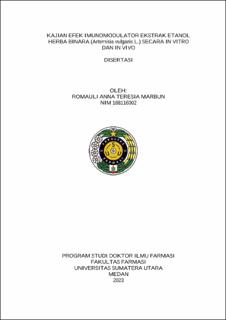| dc.description.abstract | Herbs from the Binara plant (Artemisia vulgaris L.) are potentially
medicinal herbs from Tanah Karo, North Sumatra which have been used
traditionally to overcome skin infections and hypertension. Secondary metabolites
and contained marker compounds become parameters of pharmacological
potential. Infectious diseases require alternatives to synthetic drugs. Research was
conducted to analyze the immunomodulatory effects of herbal binara. The test
was carried out by qualitative and quantitative determination of secondary
metabolites, examining the immunomodulatory effects of extracts both in vitro
and in vivo.
Pemeriksaan secara kualitatif dan kuantitatif dengan menggunakan High
Performance Liquid Chromatography (HPLC) dan Liquid chromatography-mass
spectrometry (LCMS). Kadar flavonoid total ekstrak ditetapkan dengan
menggunakan Spektrofotometri UV-Visibel. Pengujian efek imunomodulator
dilakukan dengan metode pengujian secara in vitro dan in vivo. Pengujian in vitro
dilakukan dengan pengujian viabilitas sel untuk melihat konsentrasi sel yang
paling aman dan digunakan untuk pengujian proliferasi limposit dengan
Microtetrazolium (MTT) assay. In vitro testing is done with cell viability testing
to see the safest cell concentration and is used for testing lymphocyte proliferation
with Microtetrazolium (MTT) assay. IL-6 gene expression testing using the
highest safe concentration was used to analyze gene expression in RAW 264.7
cells by Reverse Transcription-Polymerase Chain Reaction (RT-PCR) method. In
vivo testing was carried out by giving extracts for 14 days to nonimmunosuppressant
mice and suppressants given cyclophosphamide on days 8
and 13 infected with Staphylococcus aureus on day 4 measuring total leukocytes
and differentials, Ig-G levels, and IL-2 with the Enzyme-linked immunosorbent
assay (ELISA) method.
The results showed that the extract containing quercetin compounds
indicated by ethanol extract of binara herb (EEHB) showed a retention time of
5.27 minutes with m/z 300.18-301.18 and quercetin levels in the extract with a
concentration of 6.25 ppm of 7.14 μg/ml, 12.50 ppm of 13.42 μg/ml, 25.00 ppm
of 23.77 μg/ml, 50.00 ppm of 48.55 μg/ml, and 100 ppm at 100.85 μg/ml. The
results of cell viability testing from EEHB showed no toxic effect at a
concentration of 12.50; 25 μg/mL, levamisole 1.25; 2.5 μg/mL, quercetin 1.25
μg/mL with percentage of living cells (>90%). EEHB, levamisole, and quercetin
increased lymphocyte proliferation with an EC50 value of 4.527; 4,282; 2.436
μg/mL. EEHB is able to increase lymphocyte proliferation. EEHB also increased
IL-6 gene expression as seen from absorption band thickness. EEHB also
increased the number and differential of leukocytes such as lymphocytes,
neutrophils, basophils, and eusinophils, Ig-G levels, and IL-2 levels in nonimmunosuppressant
mice and suppressants infected with Staphylococcus aureus.
Based on the results of the study, it was concluded that EEHB contains
quercetin. EEHB and quercetin did not show toxic effects on RAW 264.7 cells, increased lymphocyte cell proliferation and IL-6 gene expression, also increased
total and leukocyte differential, Ig-G, IL-2 cytokine, so EEHB is effective as an
immunostimulant. | en_US |


